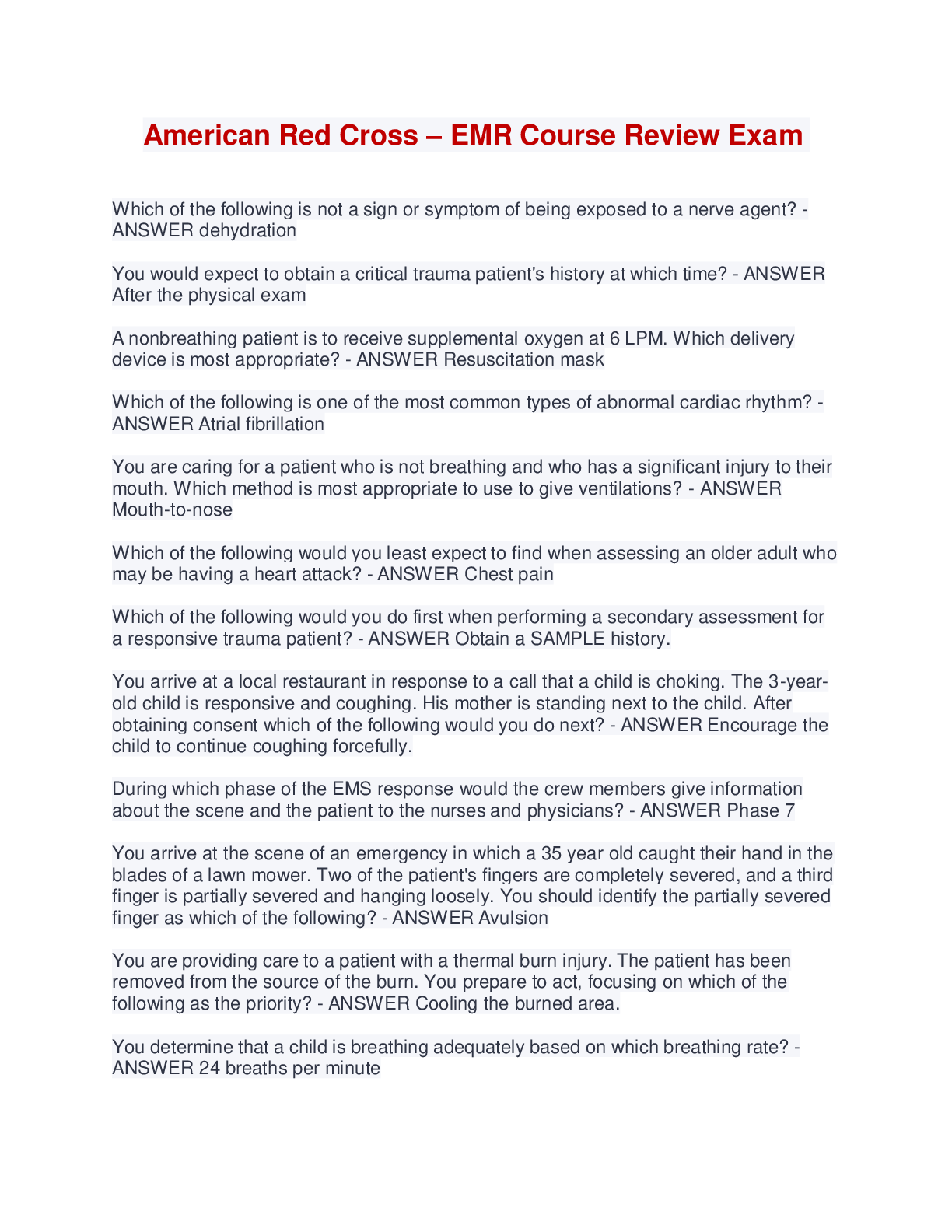*NURSING > EXAM > American Red Cross CPR/AED for the Professional Rescuer and First Aid Exam A (All)
American Red Cross CPR/AED for the Professional Rescuer and First Aid Exam A
Document Content and Description Below
American Red Cross CPR/AED for the Professional Rescuer and First Aid Exam A 1. How can you best protect yourself from possible bloodborne pathogen transmission when providing care? a. Ask the victim ... first if he or she has any communicable diseases. b. Thoroughly wash your hands before providing care. c. Use first aid supplies, such as dressings and bandages, as a barrier when in contact with the victim. d. Use personal protective equipment (PPE), such as disposable gloves and a breathing barrier, when providing care. 2. A 12-year-old boy at a swim meet grabs his chest and begins to make wheezing noises. After you obtain consent to provide care, his mother informs you that he has a history of asthma, but does not have his inhaler nearby. What care should you provide? a. Give 5 back blows. b. Summon more advanced medical personnel and place the victim into a position that helps breathing. c. Tell the victim to use an inhaler borrowed from a bystander. d. Wait 20 minutes to see if the breathing difficulty goes away. you initial impression of a victim is based on. a. the victims initial vital signs b. how the victim appears to you as you size up the scene victims SAMPLE history d. what you have been told about the victim 4. You and another lifeguard find an unconscious adult on the floor in the locker room. You activate your facility's EAP, size-up the scene and perform a primary assessment. You find the victim is not moving or breathing, but has a pulse. You should summon EMS personnel, then: a. Give 1 rescue breath about every 5 seconds. b. Give back blows and chest thrusts. c. Give quick breaths at the rate of 20 to 40 a minute. d. Perform CPR 5. You come upon a scene where a patron appears to be injured. Before approaching the victim, which of the following will you not do as you size-up the scene? a. Use all your senses to determine if the scene is safe. b. Determine what happened and how many victims there are. c. Begin the primary assessment. d. Put on appropriate PPE. 6. When providing care during an emergency, which of the following should you do first? a. Check for responsiveness. b. Perform a primary assessment. c. Size-up the scene. d. Summon more advanced medical personnel 9. As the first lifeguard on the scene, you are performing CPR on an adult. When performing chest compressions, how deeply should you compress the chest? a. About ½ inch b. About 1½ inches c. At least 1 inch d. At least 2 inches 8. CPR should be performed on which of the following victims? a. One who is conscious and has an airway obstruction b. One who is experiencing difficulty breathing c. One who is in cardiac arrest d. One who responds to painful stimuli 9. What is the first step of the Cardiac Chain of Survival? a. Early CPR b. Early defibrillation c. Early more advanced medical care d. Early recognition and access to the emergency medical services (EMS) system 10. You are providing care to a victim having a heart attack. Which of the following would you do first? a. Loosen any tight clothing. b. Monitor the victim's appearance. c. Provide comfort to the victim. d. Summon EMS personnel. 11. Once you have turned on the automated external defibrillator (AED), you should: a. Apply the pads and allow the AED to analyze the heart rhythm. b. Check for breathing. c. Give abdominal thrusts. d. Give chest compressions. 12. To ensure effective chest compressions during CPR, which of the following is most appropriate? a. Allowing the chest to fully recoil between compressions b. Compressing the chest to a shallow depth c. Placing the victim on a soft, flat surface d. Positioning the hands at the upper part of the victim's chest 13. You are performing CPR on a victim and a second lifeguard arrives. Which of the following is most appropriate for the second lifeguard to do first? a. Begin giving ventilations to the victim. b. Call for a change in position to assist with CPR. c. Check to see whether EMS personnel have been called. d. Have the first lifeguard stop CPR to allow for victim reassessment. 14. Which of the following is most essential to use when giving ventilations to protect you and the victim from disease transmission? a. CPR breathing barriers b. Protective clothing c. Gowns d. Protective eye wear 15. You are providing care to a facility maintenance worker who has fallen off the top of a ladder. The victim is conscious. Which of the following should you do first? a. Ask the victim what happened when he or she fell. b. Check the victim's pulse. c. Obtain consent from the victim to provide care. d. Question the victim about any complaints of pain. 16. For which of the following should you summon EMS personnel? a. A victim with a minor cut on the forearm that is lightly bleeding b. A victim with an airway obstruction who is forcefully coughing c. A victim with intermittent abdominal pressure d. A victim with an open leg wound with the bone protruding 17. You pull an unconscious adult from the water who is taking infrequent gasps. During the primary assessment you find that the victim has a pulse. Which of the following should you do next? a. Begin CPR. b. Check for severe bleeding. c. Continue to monitor the victim's breathing closely. d. Give 2 initial ventilations. 18. If there is a risk of the AED pads touching each other, such as with a small child or an infant, you should: a. Place one pad in the middle of the chest and the other on the back. b. Place one pad on the stomach and one pad on the chest. c. Place them as usual. It does not matter if the pads touch each other. d. Reverse the pads' position on the chest. 19. You have sized up the scene and determined the scene is safe. When performing a primary assessment, which of the following would you do next? a. Check for responsiveness. b. Summon EMS personnel. c. Open the victim's airway. d. Check for breathing and a pulse. 20. Which of the following statements about bag-valve-mask resuscitators (BVMs) is most accurate? a. BVMs are readily available at all emergency scenes. b. Monitoring the victim for full exhalation is not required. c. Two rescuers need to operate the BVM. d. When used by a single rescuer, BVMs allow easy coordination with chest compressions 21. You are preparing to give ventilations to a 5-year-old boy using a resuscitation mask. You should give 1 ventilation about every: a. 1 second. b. 2 seconds. c. 3 seconds. d. 5 seconds. 22. When compressing a child's chest during CPR, you should compress at a rate of at least how many compressions per minute? a. 80 b. 100 c. 120 d. 140 23. An AED has advised that a shock should be given. Which of the following is appropriate? a. Apply new AED pads to the victim's chest. b. Begin chest compressions immediately. c. Cover the AED pads with a blanket. d. Tell everyone to stand clear of the victim. 24. You are about to apply AED pads to a victim's chest when you notice that the victim has several body piercings with jewelry on his chest. Which of the following should you do? a.Apply the pads to the chest, making sure to avoid the jewelry. b. Remove the jewelry before applying the pads. c. Use one pad, applying it directly over the jewelry. d. Wipe the chest, including the jewelry, with alcohol. 25. The cycle of chest compressions and ventilations in two-rescuer CPR for an infant is: a. 15 chest compressions and 1 ventilation. b. 15 chest compressions and 2 ventilations. c. 30 chest compressions and 1 ventilation. d. 30 chest compressions and 2 ventilations. 26. You are positioned above the child's head and are using a resuscitation mask to give ventilations. After you position the mask, which of the following should you do next? a. Blow into the mask. b. Lower the mask over the mouth. c. Open the airway. d. Seal the mask 27. You are providing care to a patron who started choking on some food. The victim becomes unconscious. Which of the following should you do first? a. Attempt to give ventilations to the victim. b. Lower the victim carefully to the ground and open his airway. c. Give 5 chest compressions. d. Look inside the victim's mouth. 28. Where should you place your hands when giving chest compressions to an infant during CPR? a. One hand on the chin and one hand on the chest b. One hand on the chin and two or three fingers on the center of the chest c. One hand on the forehead and one hand on the chest d. One hand on the forehead and two or three fingers on the center of the chest 29. When giving abdominal thrusts to an adult, where should you position your fist? a. In the center of the breastbone b. In the middle of the abdomen, just above the navel c. In the middle of the abdomen, just below the navel d. On the rib cage 30. When providing care to a conscious infant who is choking, which of the following is most appropriate? a. Giving 10 chest thrusts then 10 back blows b. Positioning the infant so the head is lower than the chest c. Standing slightly behind the infant with one arm around the chest d. Using the heel of your hand to give the chest thrusts 31. A person has been injured and is conscious. You should: a. Have the victim walk with you to the first aid station so you can obtain consent and provide care. b. Obtain consent, check the victim for life-threatening conditions and speak with the victim to find out what happened. c. Provide care immediately based on the victim's condition. d. Speak with the victim to find out what happened and check for non-life-threatening conditions. 32. The purpose of the secondary assessment is to: a. Determine if the victim is bleeding severely. b. Identify and care for conditions that are not life threatening. c. Look for other victims you may not have noticed at first. d. Verify the victim has medical insurance. 33. An injured patron is conscious and bleeding severely. After summoning EMS personnel, obtaining consent and putting on disposable gloves, what is your next care step? a. Treat the victim for shock by lying the victim down. b. Elevate the wound if you can do so without causing further pain. c. Let the wound bleed until it stops on its own. d. Press firmly against the wound with a sterile dressing and bandage. 34. A way to remember the questions to ask when taking a brief history is to use the acronym SAMPLE. What does the A in SAMPLE stand for? a. Age b. Airway c. Allergies d. Ankle 35. What is the first step you should take in caring for a victim with burns? a. Cool the burned area to stop the burning. b. Keep the victim comfortable. c. Remove the victim from the source of the burn. d. Take steps to minimize shock. 36. If a victim is having a seizure in the water: a. Immediately get him or her out of the water. b. Immediately move the victim to shallow water until the seizure ends, if the victim is in deep water. c. Secure the victim onto a backboard. d. Support the victim with his or her head above water until the seizure ends 37. During a swim meet, the bleachers behind your guard station suddenly collapse. As you check the scene, you notice several people who appear injured. Who should you approach first? a. A mother holding a crying infant. b. A man who appears unconscious. c. A woman who is bleeding lightly from an injury on her leg. d. A child who is holding his arm, which appears to be injured. 38. When caring for musculoskeletal injuries, what does RICE stand for? a. Rest, immobilize, cold, elevate b. Remove, immobilize, care, elevate c. Rest, ice, care, evaluate d. Remove, ice, care, evaluate 39. Signs and symptoms of sudden illness do not include: a. Nausea or vomiting. b. Loss of vision or blurred vision. c. Bruising or rigidness of the abdomen. d. Changes in skin condition. 40. When checking a victim during a secondary assessment you notice changes in her LOC. What does the C stand for in LOC? a. Condition. b. Comprehension. c. Consciousness. d. Complication. [Show More]
Last updated: 1 year ago
Preview 1 out of 9 pages

Reviews( 0 )
Document information
Connected school, study & course
About the document
Uploaded On
Jun 02, 2022
Number of pages
9
Written in
Additional information
This document has been written for:
Uploaded
Jun 02, 2022
Downloads
0
Views
61
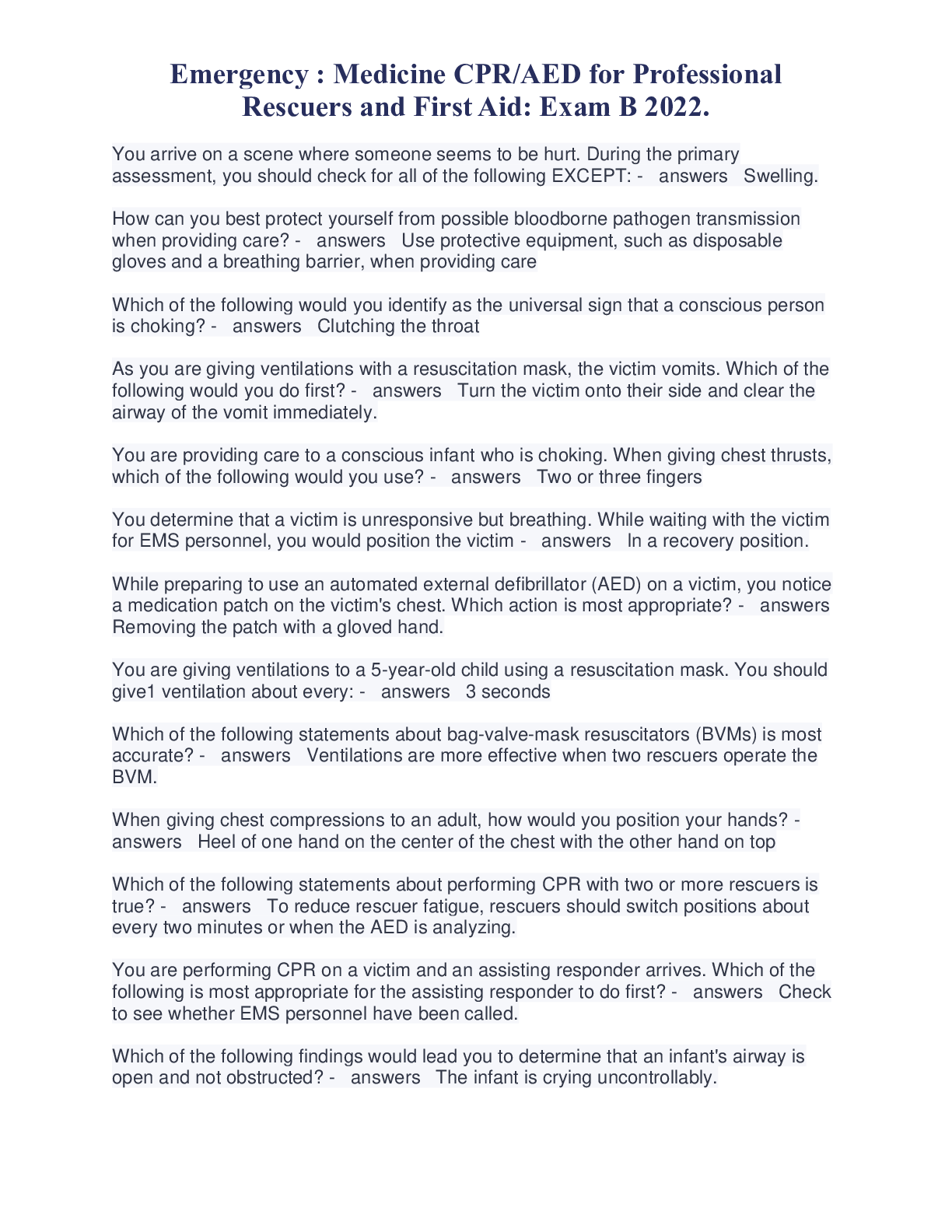

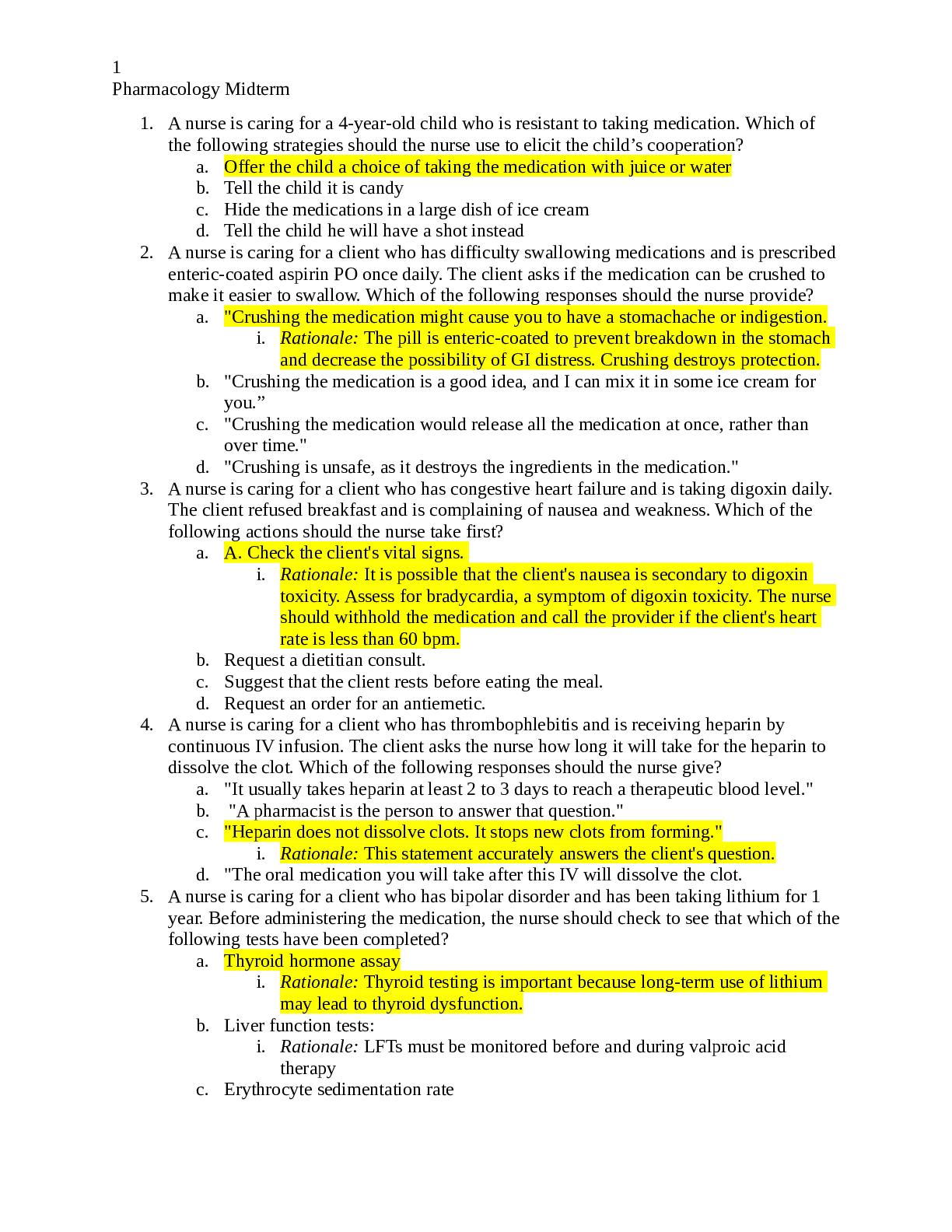
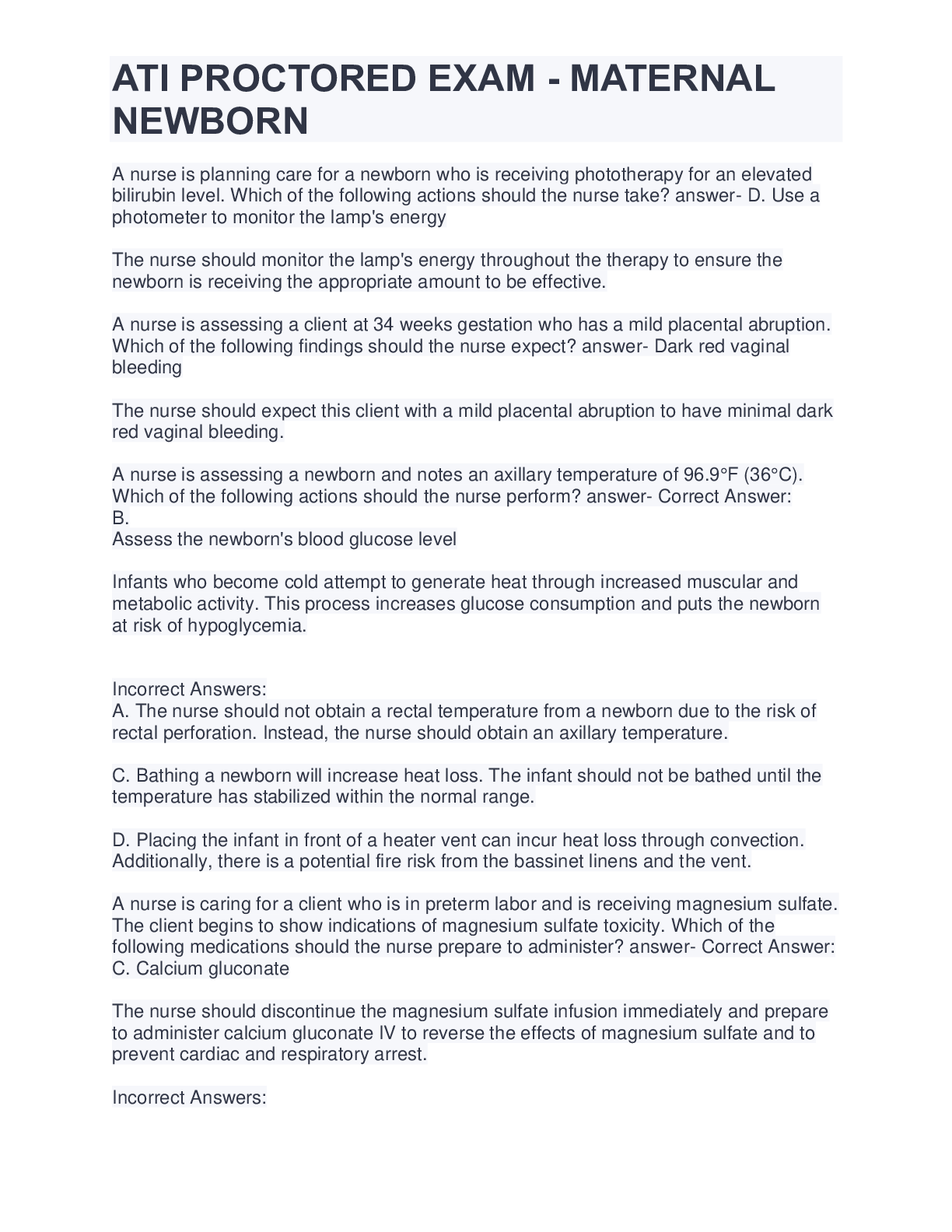

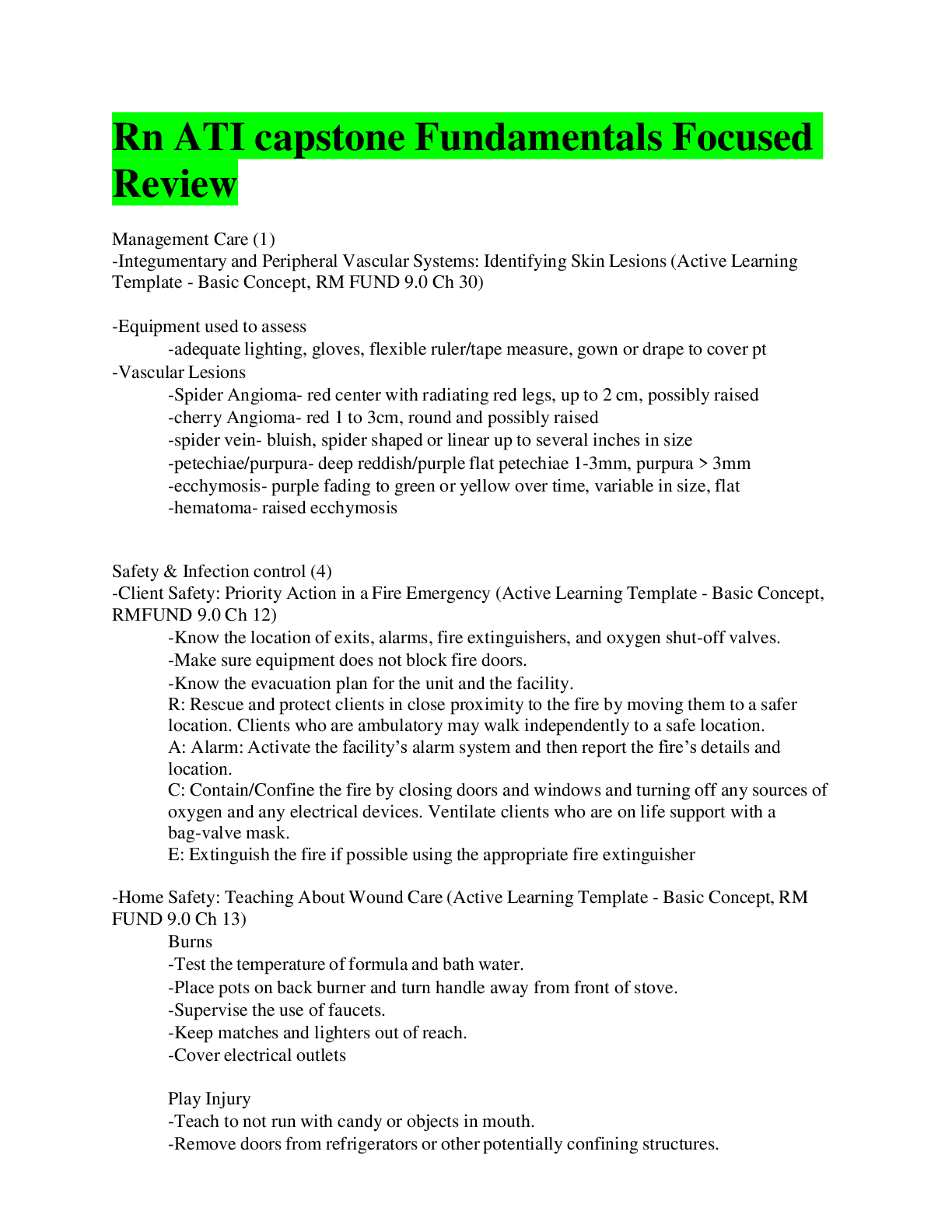
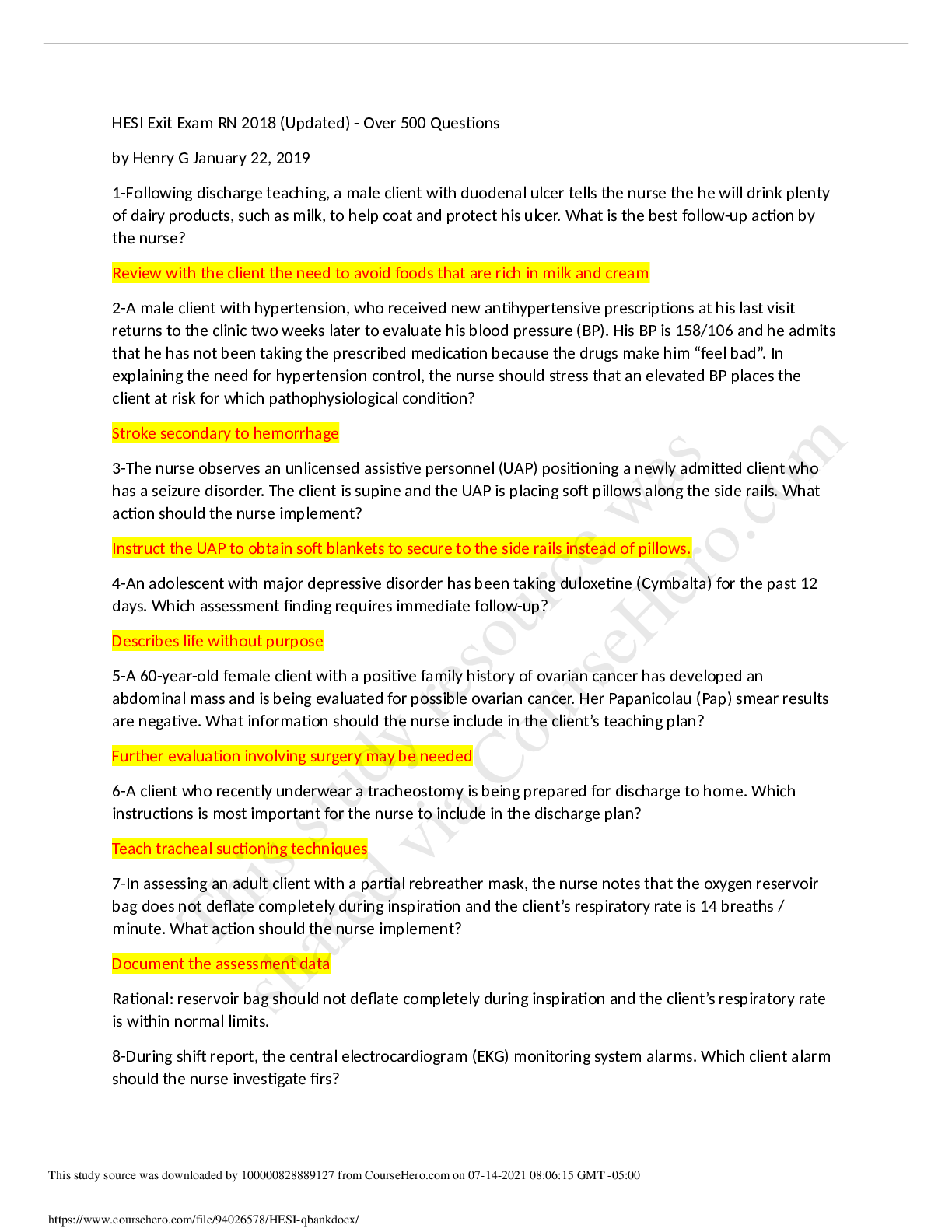



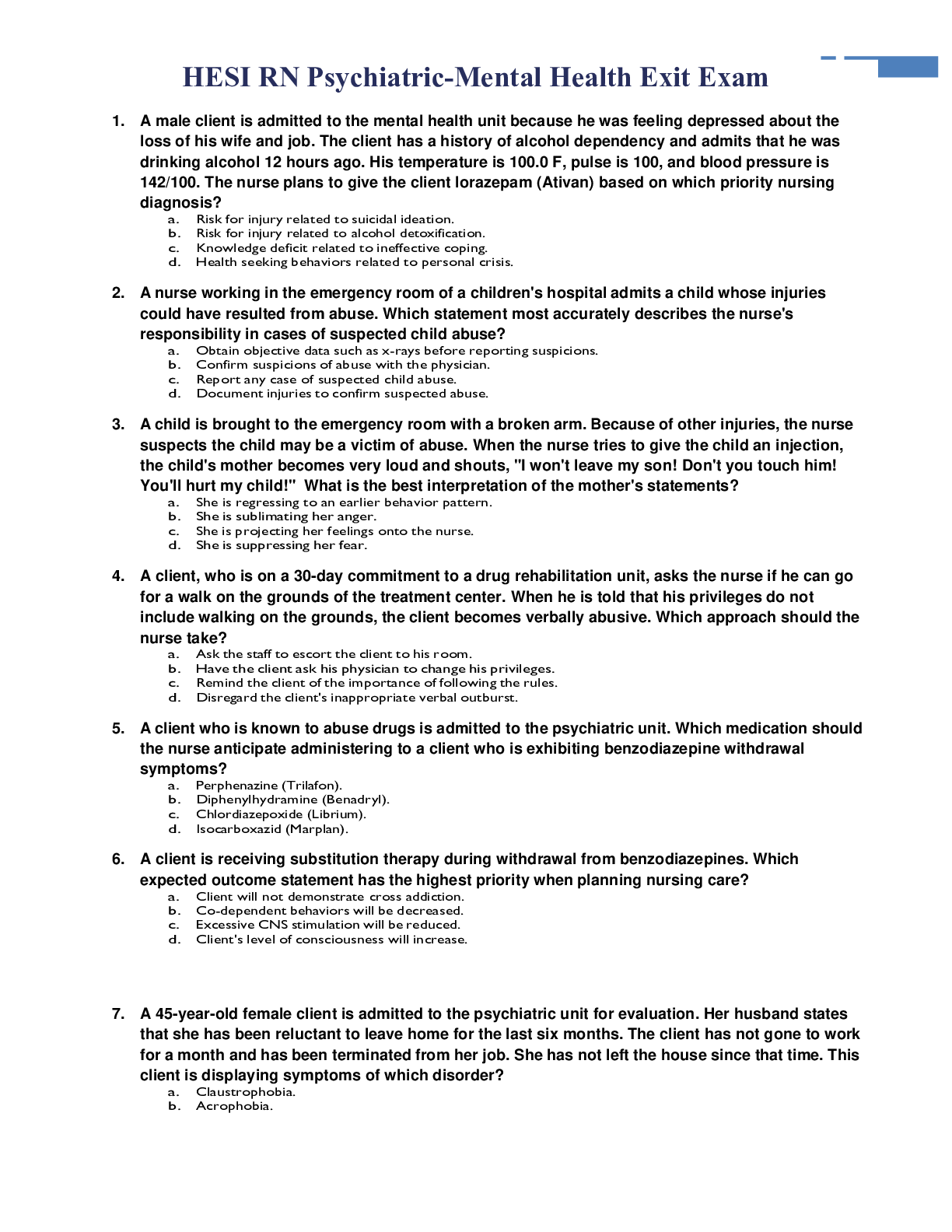
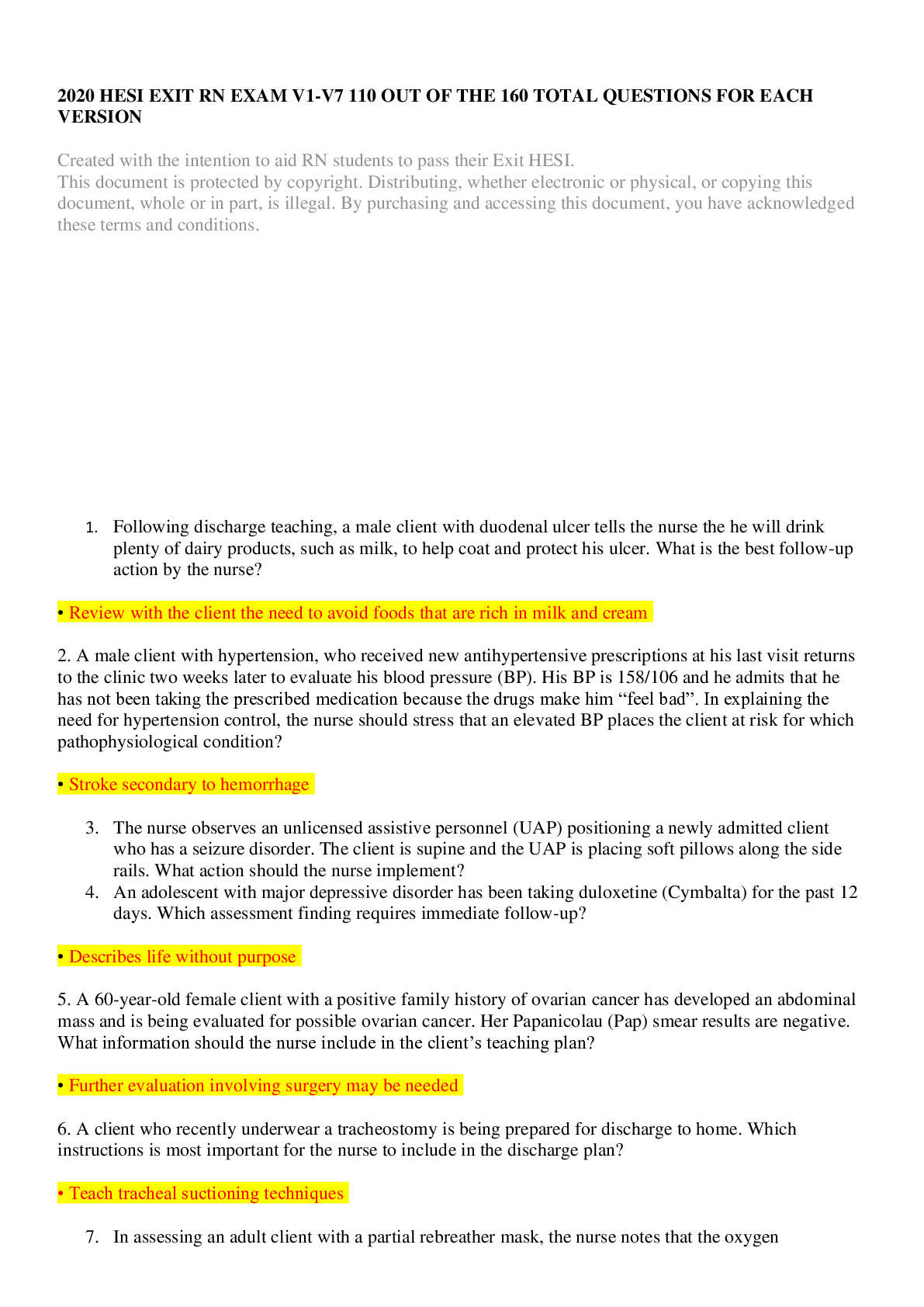
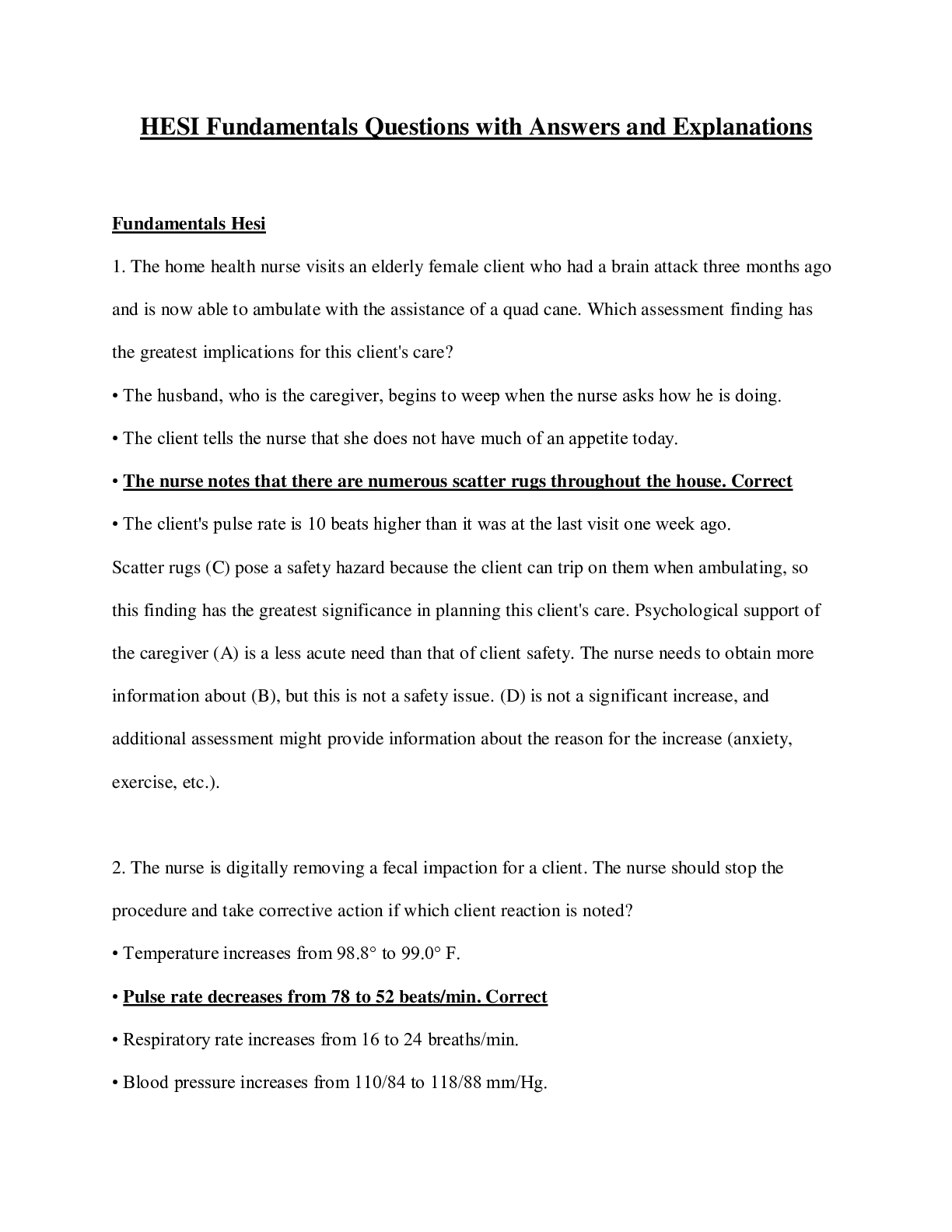
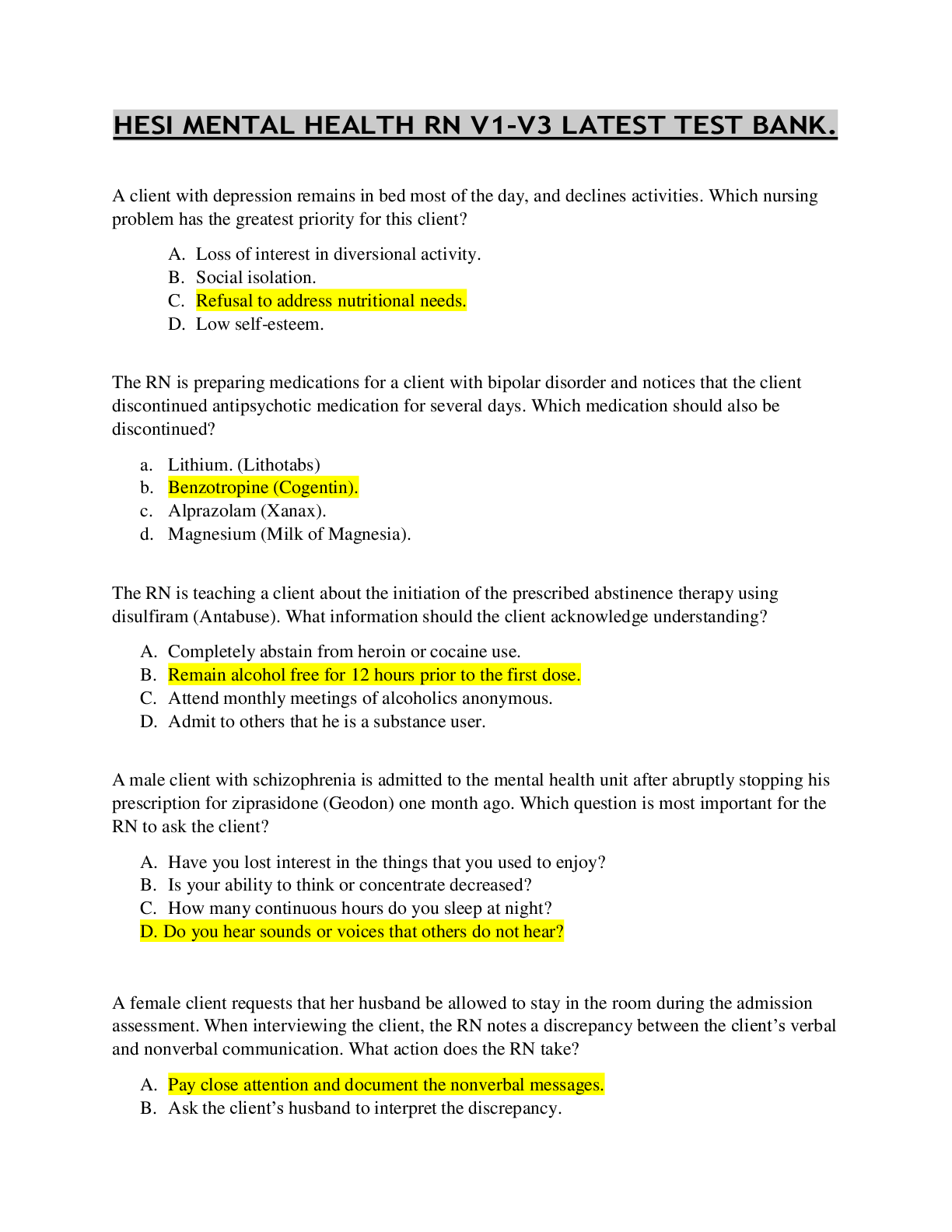

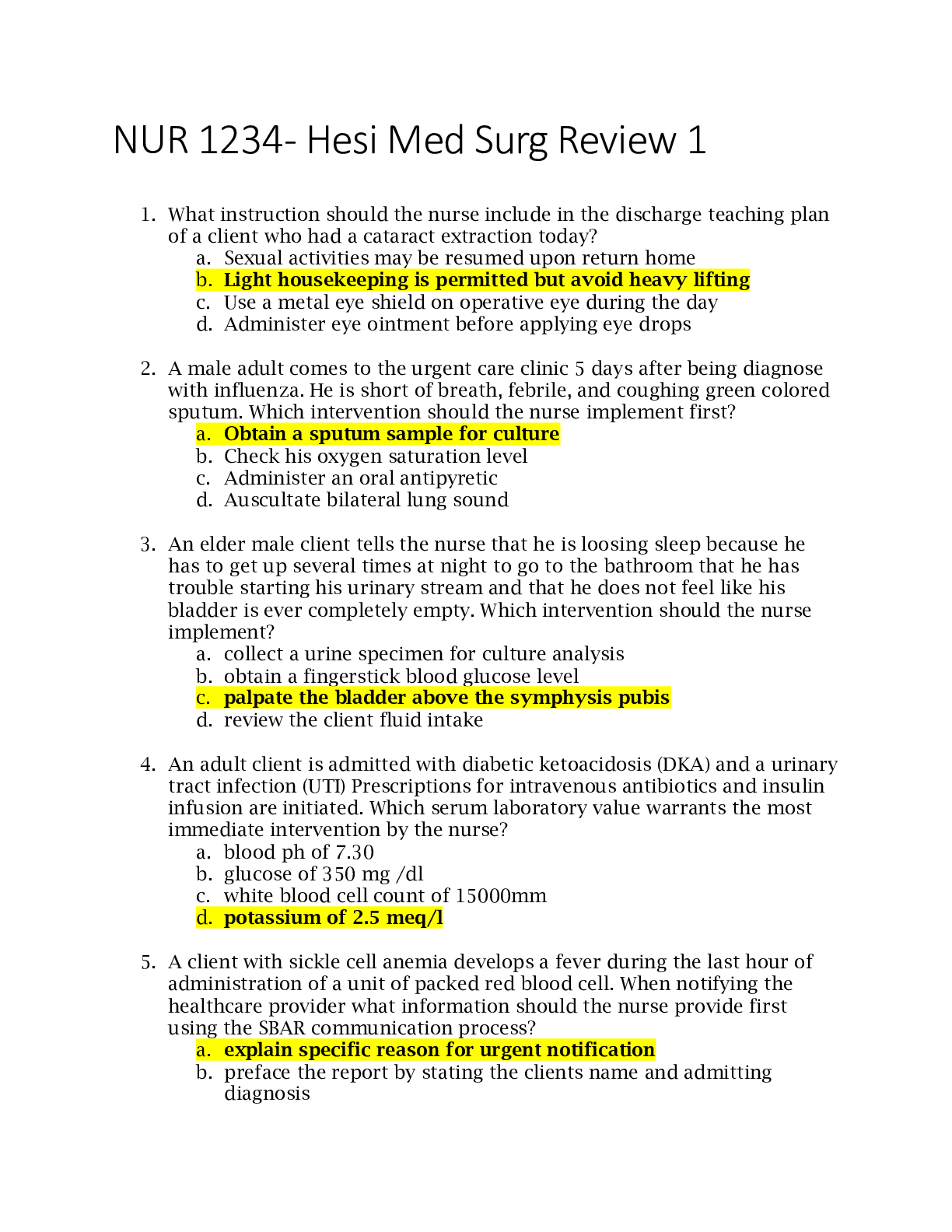
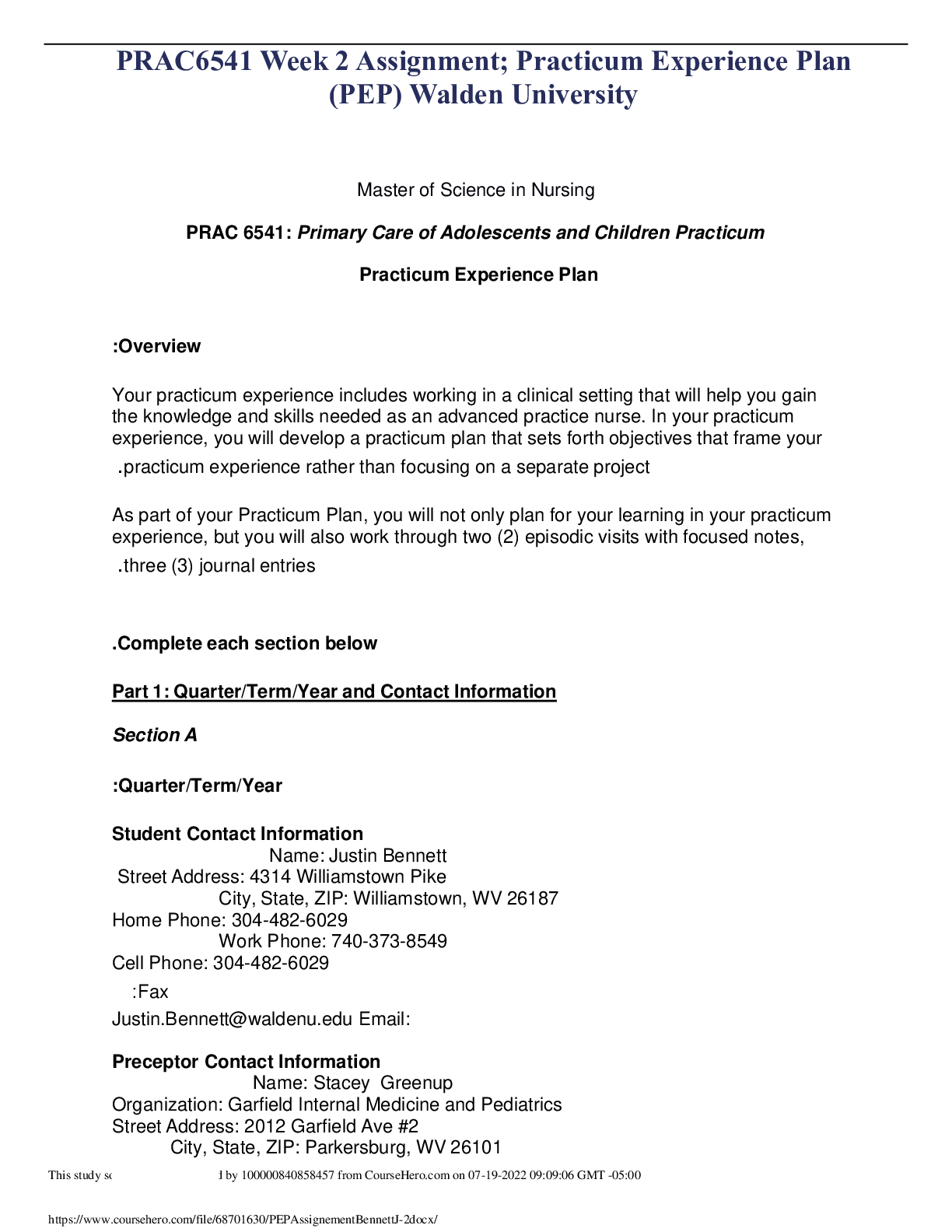


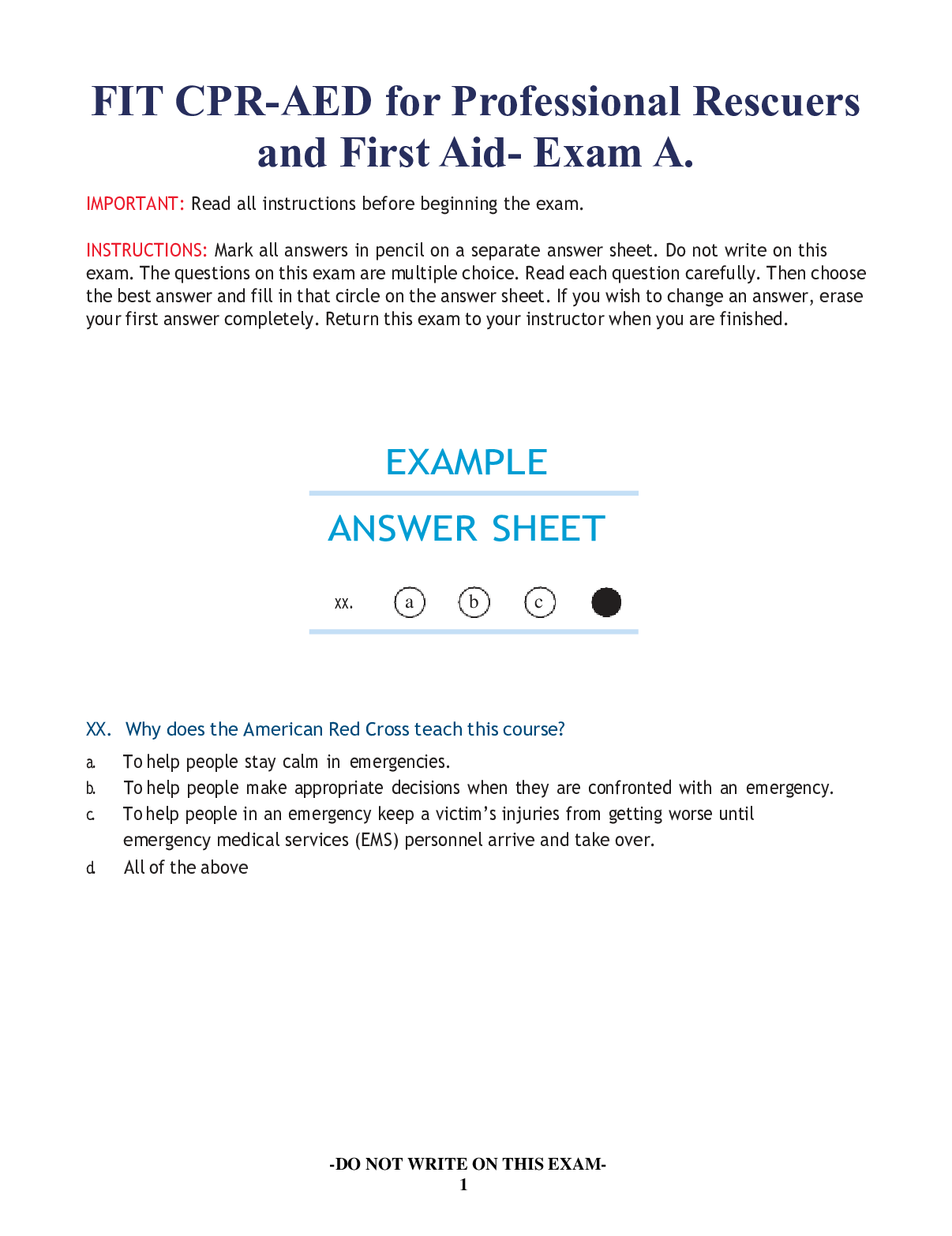
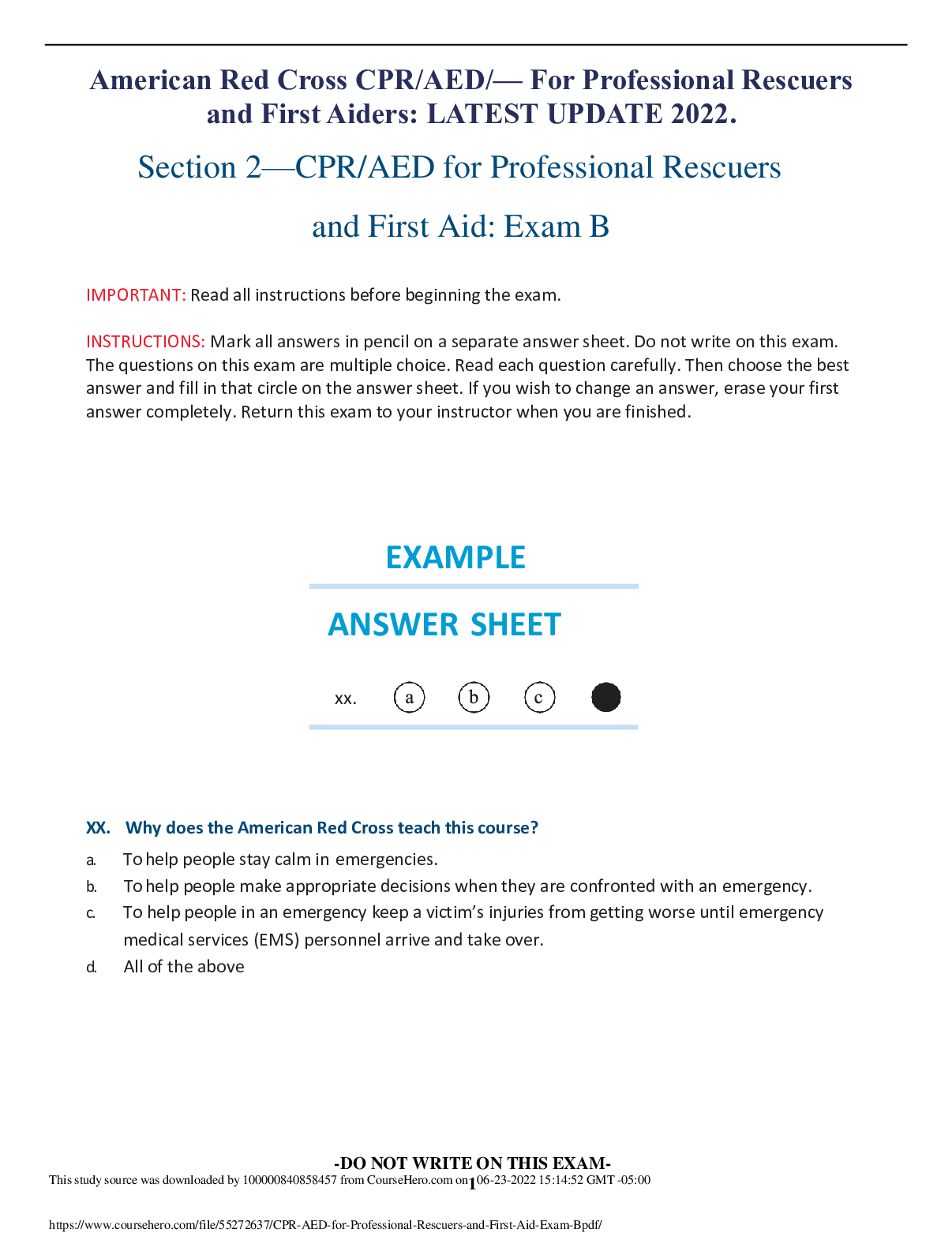

 (1).png)
